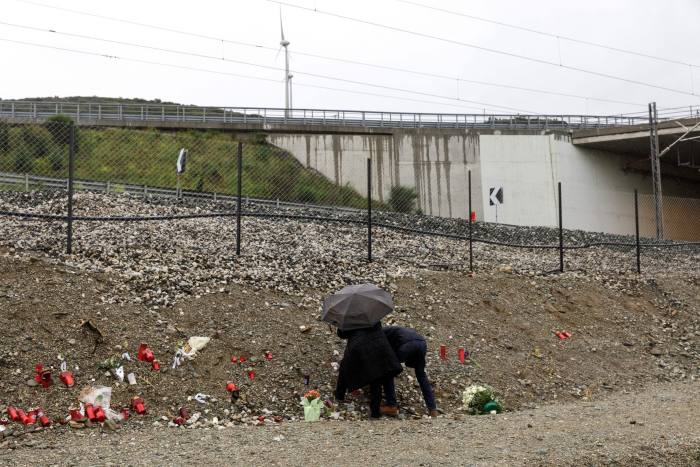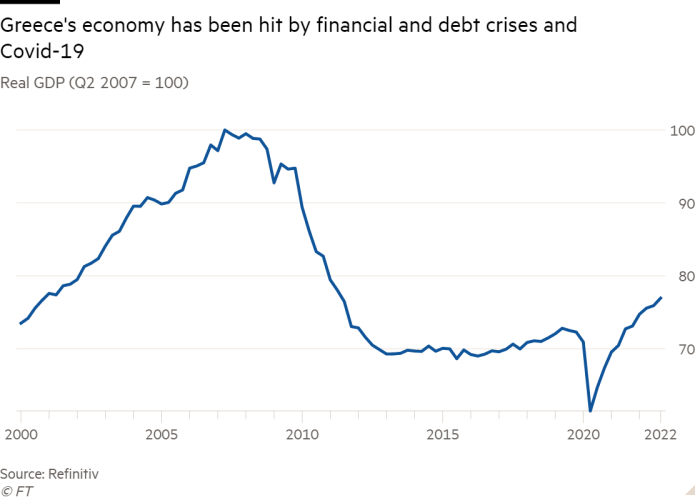Greece has resumed passenger traffic on the railway destroyed in the country’s deadliest crash more than a month ago. But the nation is still struggling to identify those responsible for the years of neglect, mismanagement and corruption that led to the accident.
The collision between a passenger train and a freight train in February claimed the lives of 57 people and has turned into a moment of reckoning about the failure of successive governments and international creditors to transform a railway operator that had accumulated €11bn in debt and had a culture of mismanagement, political favours and lack of interest in improving the safety of the network. With the accident front and centre in every public discussion, the government of Kyriakos Mitsotakis last month decided to postpone the parliamentary elections by one month to May 21.
“I’m lucky to be alive in this country. I’m embarrassed that I live in Greece,” said Vasiliki Economaki, a 19-year-old studying physiotherapy in Thessaloniki and one of the survivors of the crash. “We are all to blame, as we did nothing all these years,” she said a few days after the collision.


Passenger traffic between Athens and Thessaloniki resumed on Monday for the first time since the crash, with transport minister George Gerapetritis giving assurances that safety has been restored to the line. He said authorities were rushing to complete a new signalling and remote control system by September, in line with international safety standards.
That system was due to be installed in 2016, but it was postponed seven times. Experts argue that if the system had been in place the crash would have been avoided. “If the system existed the possibility for an accident would be one in a million,” said Christos Retsinas, former head of security for Trainose, the company that owned the trains in Greece until it was privatised in 2017 as part of bailout conditions.
Because the system was in part funded by EU money, the European public prosecutor in 2021 launched an investigation into the tender, suspecting the bloc’s financial interests might be at risk.
The causes of the accident are not fully known and the investigation continues. The stationmaster on duty has been charged with negligent homicide and his case is being handled in Greek courts.
The crash was a disaster waiting to happen, according to former executives and transport experts, given the poor state of the infrastructure and the mountain of debt accumulated by the state-owned railway operator, OSE, in the years leading up to the 2010 sovereign debt crisis.

The picture painted by former officials and executives involved with the state railway is one of successive governments that spent millions of EU and Greek funds on overpriced investments that were never completed, appointed some executives without proper qualifications, and left the railway with unfit equipment and poor maintenance.
“It is the worst version of the state, the last vestige of a state-run Soviet system, ruled by vested interests,” said Thanasis Ziliaskopoulos, the former chief executive of Trainose. “Investments were made based on political criteria and not on what the market needed.”
In 2010, officials representing the country’s creditors went through public accounts and found a railway company saddled with €11bn of debt. Their mandate was to make it financially viable. And even though to some extent they did, the company was never truly reformed.
In the years preceding the economic meltdown that hit the country, the railway company’s debt was rising by 55 per cent annually. When Ziliaskopoulos took over as chief of Trainose in 2010, “the company was facing financial chaos”, he said. He was faced with an annual deficit of €240 million euros just to keep operations going.
At one of the first meetings with IMF representatives in the spring of 2010, Ziliaskopoulos remembered one of them shouting “shut it down!” — because it was deemed a hopeless case.
“A railway company with 11bn of debt means that there was severe mismanagement,” said Thomas Wieser, who was the euro area’s chief official during much of the sovereign debt crisis. “You need politicians who really want to do something about it. [I’m] not sure that was the case in Greece and that is why a shock therapy was needed.”

When Greece’s bailout conditions were drafted, the “troika” of international creditors called for the railway’s operational activities to become profitable.
One of the measures was to cut back on staff. Greece’s railways employed 12,500 people in 2010. After the troika’s involvement, just 2,600 remained employed by OSE and in 2021 numbers had further reduced to 2,000.
Takis Theofanopoulos, who took over as president of OSE in 2010, said that as experienced train and railway station workers reached retirement age, “I knew we would soon face shortages that would be hard to deal with.”
Other restructuring measures included slashing the generous pay deals trade unions had secured for railway workers and cutting back on train connections with few passengers. The culture was slow to change, however. Fuel was routinely stolen from the company’s stock and free tickets were handed out as political favours, with the company struggling to make any profits, according to Ziliaskopoulos.
Well aware of the deteriorating infrastructure, he sought to compensate by appointing extra safety personnel onboard and in all main stations. “I did not sleep peacefully at night,” he said.
A further challenge to the safety of the network was frequent raids by copper thieves. “It was impossible to safeguard 2,500km of rails without an organised plan by the police and secret services,” said Theofanopoulos, who said the problem persists. Even if a modern signalling system were to be placed in the rails, it would end up being stolen, he said.
Soon after Greece exited its reform program in 2018 the extra layers of security that were put in place in previous years started being eliminated.

Trainose was sold to Italy’s state-owned railway company, renamed Hellenic Train in 2022 and given control of passenger and freight operations, while OSE kept control of the network.
“The supervisor of the train master was stripped of his responsibilities, while the control centre in Athens was split into two,” said Retsinas. “With these changes, an accident was waiting to happen.”
Hellenic Train said it operates “in full compliance” with railway sector rules, adding that it has “two train drivers in the cockpit, and a master conductor in the coaches”.
Stay connected with us on social media platform for instant update click here to join our Twitter, & Facebook
We are now on Telegram. Click here to join our channel (@TechiUpdate) and stay updated with the latest Technology headlines.
For all the latest Business News Click Here
